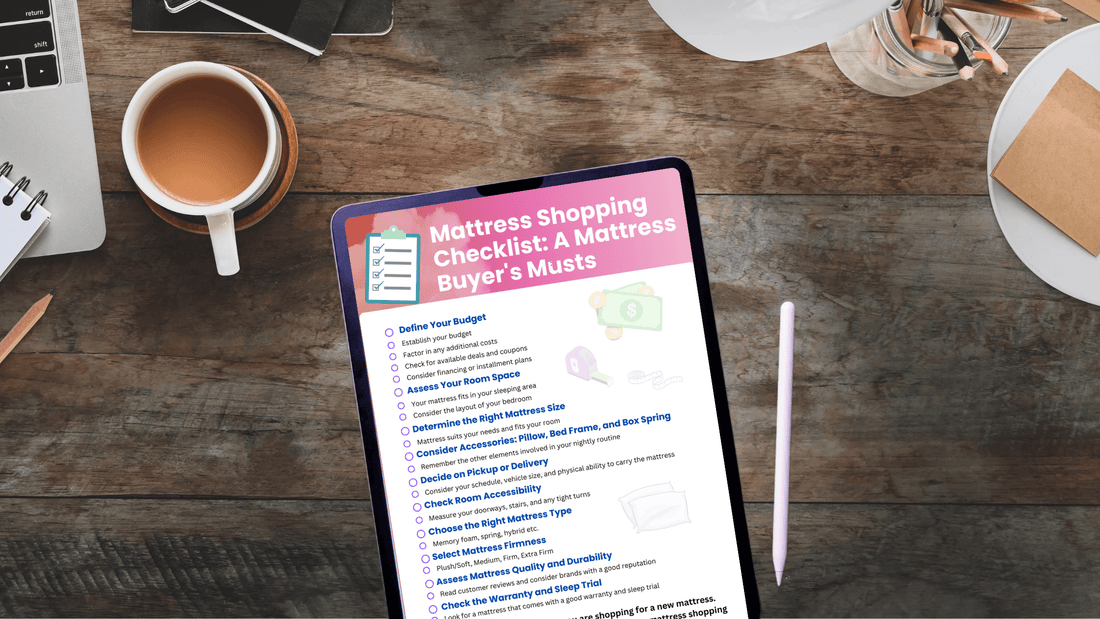Mattress Shopping Checklist: A Mattress Buyer's Musts
Shopping for the perfect mattress can feel like a quest for the Holy Grail of sleep. With so many options out there mattress shopping can be as overwhelming as it is exciting whether you buy online or in-store.
Welcome to Mattress Shopping 101! Want to know the best mattress of 2023? Are you looking for a mattress buying guide or just some solid mattress shopping tips? You are in the right place.
We will guide you through the need to know, like what to ask when buying a mattress and finding the best mattress that suits your needs.
When buying a new mattress, many things come into play. Is a firmer mattress better than a softer one? What is the best type of mattress for side sleepers? Are popular mattresses better?
--So where do you start?
We understand that shopping for a mattress is not just about acquiring a piece of furniture; it's about investing in your health, comfort, and quality of life. Your bed plays a pivotal role in a peaceful night's rest. The right bed will help put an end to tossing and turning and even provide relief from chronic back pain.
We put together this handy guide that includes a downloadable mattress shopping checklist PDF. Save this checklist to help you find a mattress.
Mattress Shopping Checklist
- 1. Define Your Budget
- 2. Assess Your Room Space
- 3. Determine the Right Mattress Size
- 4. Consider Accessories: Pillow, Bed Frame, and Box Spring
- 5. Decide on Pickup or Delivery
- 6. Check Room Accessibility
- 7. Choose the Right Mattress Type
- 8. Consider Firmness Level
- 9. Look for Quality and Durability
- 10. Check the Warranty and Sleep Trial
- Conclusion
- FAQ
1. Define Your Budget

First things first, you need to establish your budget. Mattresses come in a wide range of prices, depending on the brand, materials, size, and technology. Knowing your budget will help you narrow down your options and prevent you from overspending.
Start by determining how much you're willing to spend. Mattresses have many price points, so setting a realistic budget is the first step. Keep in mind that you spend about a third of your life on your mattress, so it's an investment in your well-being.
Some retailers offer financing or installment plans, allowing you to spread the cost of a more expensive mattress over several months. While this can make a high-quality mattress more affordable in the short term, be sure to understand the interest rates and terms.
Don’t forget to factor in any additional costs, such as delivery, setup, or a new bed frame if your current one isn't compatible with the new mattress.
Lastly, check for available deals and coupons at your preferred retailer to save even more money!
2. Assess Your Room Space

Next, consider the size of your room. Your new mattress should fit comfortably in your sleeping area without crowding the space. Be sure to measure your room before settling on a mattress size.
Make sure to consider not only the length and width but also the height of the room. This will help you choose the right mattress size that fits comfortably within the room without overcrowding it.
Consider the layout of your bedroom. Think about the placement of other furniture, such as nightstands, dressers, and closets. Ensure there's enough space to move around and access these items comfortably. Leave space for the bedroom door to open and close without obstruction.
3. Determine the Right Mattress Size

Mattress sizes vary from twin to king or even California king. The right size for you depends on your sleeping habits, the number of sleepers, and room space. For example, a king size would be suitable for couples, while a twin or full size would be perfect for a single sleeper.
Each size offers different dimensions, so choose the one that suits your needs and fits your room comfortably. Here is a quick breakdown of each size to help you get started:
- Twin: 38 inches by 75 inches
- Twin XL: 38 inches by 80 inches (5 inches longer than a standard Twin)
- Full: 54 inches by 75 inches
- Queen: 60 inches by 80 inches
- King: 76 inches by 80 inches (can be split into two Twin XL mattresses)
-
California King: 72 inches by 84 inches (narrower but longer than a standard King)
4. Consider Accessories: Pillow, Bed Frame, and Box Spring

When shopping for a mattress, don't forget about the other elements involved in your nightly routine. This includes pillows, bed frames, and box springs. Your pillow should support your neck and align with the mattress's firmness. The bed frame should be sturdy and match the size of your mattress, while the box spring can add height and support.
When shopping for these accessories, consider their quality and how they complement your mattress. Investing in the right accessories can not only improve your sleep quality but also protect your mattress investment, making it more comfortable and long-lasting.
5. Decide on Pickup or Delivery

Some people prefer to pick up their mattresses from the store, while others opt for home delivery. This choice depends on your schedule, vehicle size, and physical ability to carry the mattress. Most mattress companies offer home delivery, sometimes even with a white-glove service that includes installation and old mattress removal.
Be clear on the delivery charges. Some stores have free delivery within a certain radius or if you spend a minimum amount, while others may charge a fee. Confirm the cost upfront to avoid surprises.
Whether you're picking up a mattress in-store or receiving it via delivery, inspect the mattress for any damage or defects before accepting it. If you notice any issues, report them to the retailer immediately.
6. Check Room Accessibility

Before your mattress arrives, make sure it can reach your bedroom. Measure your doorways and any tight turns to avoid any unpleasant surprises. If access is difficult, consider a bed-in-a-box mattress that expands once unwrapped.
If your bedroom is not on the ground floor, assess how you'll get the mattress up or down staircases or through elevators. Larger mattresses or box springs can be challenging to maneuver in tight spaces.
Check whether the mattress store or delivery service can handle these logistics. Some companies have experience navigating challenging spaces, while others may charge extra fees for such deliveries.
7. Choose the Right Mattress Type

Mattresses come in different types, including innerspring, foam, latex, and hybrid. Each type has its own set of pros and cons, and the best one for you depends on your personal comfort and support needs. Here is a breakdown of some pros and cons for the most common mattress types to make this easier for you.
Innerspring Mattresses:
- Pros:
- Good support for all sleep positions.
- Good airflow, helping with temperature regulation.
-
Various firmness options are available.
- Generally more affordable than other types.
- Cons:
- May not contour as well as foam mattresses.
- Springs can create motion transfer, which may disturb a partner.
- Durability can vary based on the quality of materials.
- Pros:
- Outstanding pressure relief and support, especially for those with aches and pains.
- Minimal motion transfer, making them great for couples.
- Available in various firmness levels.
-
Reduced noise compared to innerspring mattresses.
- Cons:
- Heat retention can be an issue in some models, but many now come with cooling features.
- A "sinking" feeling can be bothersome for some sleepers.
- May emit a slight odour when new (off-gassing), which dissipates over time.
- Pros:
- Exceptional durability, with latex mattresses often lasting 10 years or more.
- Provides excellent support and pressure relief.
- Naturally hypoallergenic and resistant to dust mites and mould.
-
Less off-gassing compared to some memory foam mattresses.
- Cons:
- Can be relatively expensive.
- Heavy and difficult to move.
- Limited availability and fewer options in some areas.
- Pros:
- Good support and pressure relief.
- Enhanced breathability compared to some all-foam mattresses.
-
Varies firmness options and materials.
- Cons:
- Cost can be higher than traditional innerspring or foam mattresses.
- May not excel in any particular category compared to specialized mattress types.
8. Consider Firmness Level

The firmness level of a mattress is crucial for your comfort. Side sleepers usually prefer a soft to medium mattress, back sleepers benefit from a medium to firm mattress, and stomach sleepers generally need a firm mattress.
Remember that mattress firmness can be subjective, and what feels comfortable to one person may not work for another.
9. Look for Quality and Durability

A good quality mattress can last up to 10 years or more. Look for high-quality materials and excellent craftsmanship. Read customer reviews and consider brands with a good reputation for durability.
10. Check the Warranty and Sleep Trial

Finally, look for a mattress that comes with a good warranty and sleep trial. The warranty should cover manufacturing defects and sagging beyond a certain depth. The sleep trial allows you to test the mattress at home for a few weeks or months to ensure it's the right fit for you.
Conclusion

Mattress shopping is now simpler with our detailed checklist and insightful tips. Remember, the perfect mattress is not just about comfort. Find a bed that relieves pressure, comforts aches and pains, supports your body, and regulates temperature for a cooler sleep so you don't sleep hot.
Consider each factor carefully – from budgeting and room space to mattress type and firmness level.
The importance of quality and durability cannot be overstated, as a good mattress is an investment in your health and well-being for years to come. And with options like sleep trials and warranties, you can make this significant decision with confidence and peace of mind.
So, armed with this knowledge and your personalized checklist, you're now ready to shop like a pro. Find the one that meets your unique needs, and look forward to nights filled with comfortable sleep and happy mornings. Here's to finding your perfect mattress and to the many nights of blissful sleep that await you! Happy mattress shopping!
Download Checklist

Don't forget to save a copy and share!
- Desktop: Right click the image, and click save image
- or right click, then open in a new tab. Then right click and click save
- Mobile: Hold the image until the menu pops up and click download/save
- OR Download PDF version here
FAQ: Mattress Shopping Questions
Q. How do I determine if a mattress has the right balance of support and comfort for my body type?
A. This is a common concern, especially for those with specific physical needs. Look for mattresses that offer zoned support, which means they provide different levels of firmness in different areas (like firmer support for the lower back). It's also wise to consider your weight and body shape. Heavier individuals may need a firmer mattress to prevent excessive sinking, while lighter individuals might prefer a softer feel. Reading reviews from people with a similar body type can be very helpful.
Q. How can I test a mattress's durability before purchasing?
A. Durability is a top concern in mattress shopping. While you can't fully test this in a short trial period, you can look for indicators like the density of foam used (higher density usually means more durability), the type of coils in innerspring mattresses, and the thickness of the mattress. Also, check the warranty – a longer warranty can be a good indicator of the manufacturer's confidence in their product's durability.
Q. What's the best approach to choosing a mattress for couples with different sleeping preferences?
A. This is a common issue. Look for mattresses that offer good motion isolation and can cater to different sleeping positions. Hybrid mattresses are often a good compromise, as they provide the support of springs with the comfort of foam. Some companies also offer customizable mattresses where each side can be tailored to individual preferences.
Q. How do new mattress materials and technologies compare to traditional ones in terms of sleep quality and health benefits?
A. There's a lot of interest in how newer materials like gel-infused memory foam or copper-infused mattresses stack up against traditional ones. These new technologies often offer better temperature regulation, which is crucial for a good night's sleep. Materials like copper-infused foam are also touted for their antimicrobial properties.
However, personal preference plays a big role here – some people still prefer the feel and bounce of traditional innerspring mattresses. It's important to consider both the innovative features and your personal comfort preferences.
TLDR; Mattress Shopping Checklist
When shopping for a mattress, consider your budget, room size, mattress size, and additional accessories like pillows and bed frames. Choose the right mattress type (innerspring, foam, latex, hybrid) and firmness level based on your sleeping position and comfort preference. Assess durability through materials and warranty, and opt for a mattress with a sleep trial to ensure it meets your needs.
For couples with different preferences, look for mattresses with good motion isolation or customizable sides. New mattress technologies like gel-infused memory foam offer improved temperature regulation and health benefits, but personal comfort preference is key.










